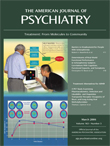Neuroleptic Malignant Syndrome Related to a Switch to Perospirone and Anticholinergic Withdrawal
To the Editor:
We report the first case, to our knowledge, of neuroleptic malignant syndrome related to perospirone. The patient’s medication had been switched from olanzapine and an anticholinergic drug approximately 2 weeks previously. When treated with perospirone without anticholinergics, the patient had a fulminant neuroleptic malignant syndrome that was complicated with rhabdomyolysis and acute renal failure.
Mr. A, a 43-year-old man, had suffered from paranoid schizophrenia for 27 years. He had been admitted to a psychiatric hospital 11 times between the ages of 21 and 33 because of insomnia, psychomotor agitation, and persecutory delusions. His illness had been maintained with a dose of 9–15 mg/day of bromperidol for more than 20 years. Bromperidol is a butyrophenone neuroleptic that shows a similar pharmacodynamic response as haloperidol. Six weeks before his admission, Mr. A’s medication was switched to risperidone and biperiden, and bromperidol was discontinued because of the drug-induced extrapyramidal symptom of a hand tremor.
Three weeks later, risperidone was switched to olanzapine because Mr. A felt that risperidone did not effectively treat his symptoms. After Mr. A had been taking the medication for 3 weeks, olanzapine and biperiden were discontinued, and perospirone, 16 mg/day, was introduced because of psychiatric symptoms, such as auditory hallucinations and diarrhea. On the 12th day of perospirone treatment, Mr. A suddenly became confused and obtunded with severe muscle rigidity. When he was admitted to a psychiatry department, he had a high fever, tachycardia, and severe extrapyramidal symptoms. Laboratory tests showed an elevation of creatine phosphokinase (33,878 IU/liter) and leukocyte levels (30.9×109/liter). A urine analysis showed myoglobinuria. A brain computerized tomography scan showed no remarkable change, and the possibility of infectious disease was excluded.
Mr. A had a fulminant neuroleptic malignant syndrome complicated with rhabdomyolysis and acute renal failure. On the third day of admission, he was transferred to an intensive care unit. He received dantrolene treatment and hemodialysis. On the 19th day, the fever disappeared, and his serum creatine phosphokinase level was normal (112 IU/liter). On the 44th day, his muscle rigidity was resolved, and no psychiatric symptoms were observed. He was discharged on the 46th day.
This case report shows that neuroleptic malignant syndrome can occur after a switch to perospirone treatment from other antipsychotics and anticholinergic withdrawal. Perospirone is a novel serotonin-dopamine antagonist and also a partial serotonin (5-HT1A) agonist (1). The receptor binding profile and pharmacological property of perospirone resemble those of risperidone, and side effects, such as extrapyramidal symptoms, tend to occur less often with perospirone (2). This patient did not develop neuroleptic malignant syndrome during previous risperidone and olanzapine treatment with anticholinergics. It has been reported that abrupt withdrawal of anticholinergic agents is associated with neuroleptic malignant syndrome (3). Special caution with regard to concomitant drugs is therefore necessary when switching between antipsychotic drugs.
1. de Paulis T: Perospirone. Curr Opin Investig Drugs 2002; 3:121–129Medline, Google Scholar
2. Onrust SV, McCellan K: Perospirone. CNS Drugs 2001; 15:329–337Crossref, Medline, Google Scholar
3. Spivak B, Gonen N, Mester R, Averbuch E, Adlersberg S, Weizman A: Neuroleptic malignant syndrome associated with abrupt withdrawal of anticholinergic agents. Int Clin Psychopharmacol 1996; 11:207–209Crossref, Medline, Google Scholar



